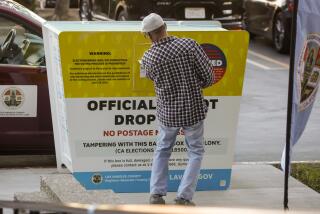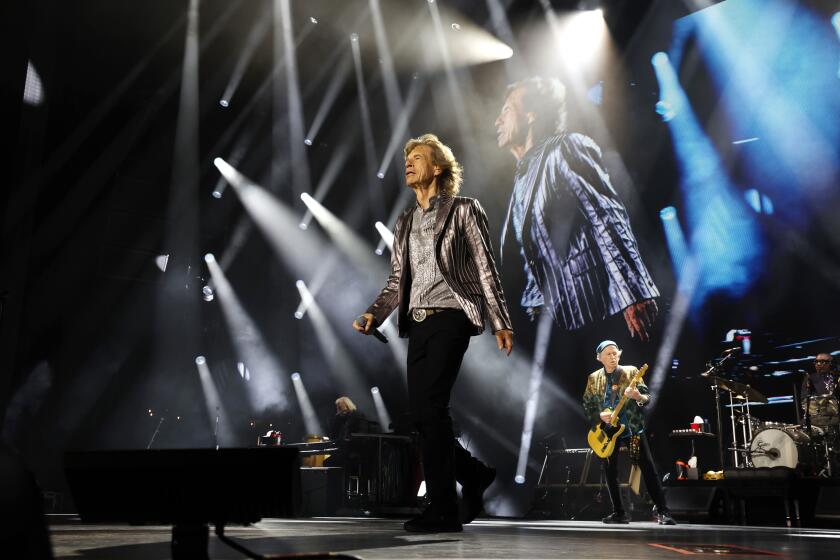California mail-in voters a primary target
As New Hampshire throws the presidential contest toward California and the other Feb. 5 contest states, the major candidates are working furiously to sew up the first of those to cast ballots -- the mail-in voters, who started receiving their ballots Monday.
At least half of California’s votes will be by mail in the presidential primary, analysts believe, and their heft is one of several factors dictating the campaigns’ strategies here.
For campaigns doing well, strategists hope to build on early momentum by convincing those key voters to return ballots swiftly. Candidates whose campaigns have fallen on hard times, on the other hand, are torn between holding off until news is better or scrambling to attract whatever votes they can before their candidacies sustain more damage.
For mail-in voters itching to fill out ballots for a favored candidate, the topsy-turvy presidential contest poses its own problem. Namely, they have no way of knowing whether a candidate they vote for today will be in the race tomorrow.
“A lot of people could end up casting ballots for candidates who are not candidates by Feb. 5,” said Dan Schnur, a veteran Republican political consultant who is unaligned in the presidential contest.
In November 2006, the last statewide election, more than 41% of those who voted cast ballots by mail. The percentage this year is unknown because voters can still apply for mail ballots for several weeks, and their strength depends on overall turnout.
Whatever their numbers, vote-by-mail balloters, known as “absentee” voters before rules regarding such votes were broadened in 2001, are prized because of their reliability.
Stephen Weir, president of the state association of registrars, said that in his county, Contra Costa, 70% to 75% of mail-in voters cast ballots in each election. Among more traditional voters, he said, turnout rates are in the range of 20% to 25%.
“By harvesting permanent absentee voters, you’re harvesting the most frequent and most likely voters,” he said of the campaigns’ efforts to entice them.
Those efforts add another level of complication to an election made vexing by the delegate selection process used by the state parties this year. Republicans will award their 173 delegates according to the winners in the state’s congressional districts -- in effect, meaning that instead of one statewide election, Feb. 5 will be made up of 53 separate ones.
Democratic delegates are even more confusingly allocated, with 370 handed out via various formulas, including district victories.
While the traditional mode of communication to California voters -- television -- has not yet been used, the campaigns for president have not been sitting idle as Iowa and New Hampshire enjoyed border-to-border attention.
Each night, thousands of phone calls are being made to voters targeted as potential supporters. Volunteers for Barack Obama, the senator from Illinois who won last week’s Iowa Democratic caucuses, have contacted nearly 300,000 mail-in voters and are starting to call them again.
“We’re trying to get the ones that we know to mail it in right away,” said state director Mitchell Schwartz. “Whether they will or not, who knows?”
Not that it’s left to whimsy: The campaign has signed up close to 3,000 precinct captains whose task will be to prod Obama loyalists and undecided voters to cast ballots. Volunteers are being trained to make calls from now until election day, and voters will soon be deluged by mailers as well.
Obama’s chief competition in California, as nationally, is New York Sen. Hillary Rodham Clinton, who has been cultivating the state since before her husband’s 1992 presidential election. Clinton’s campaign sent its first brochure to mail-in voters in late November.
While the news for Clinton has been bleak lately -- her third-place finish in Iowa led to a slump in New Hampshire as today’s balloting there approached -- her California team professes confidence.
“One thing about Californians is that they are an independent-minded group of people,” said Ace Smith, Clinton’s state director. “I don’t think voters in California are going to be swayed by things in other states. . . . She has a rock-solid base of support here.”
But the most recent state polls showed slippage even before Iowa. In a mid-December Field Poll, Clinton led Obama 36% to 22% -- a substantial lead but far less than her 25-point margin in October.
In a commentary on the turn of events, a missive from Smith to reporters two days ago included this vow on behalf of the former national front-runner: “We are in this campaign for the long run.”
The Republican contest has also outpaced the California polls. In the same December survey, former New York City Mayor Rudolph W. Giuliani led with 25%, compared with 17% for former Arkansas Gov. Mike Huckabee, 15% for former Massachusetts Gov. Mitt Romney and 12% for Arizona Sen. John McCain.
But that was before Huckabee upended the GOP contest with a victory in Iowa, and Romney began losing ground to McCain in New Hampshire. McCain’s effort here is predicated on a win in New Hampshire reminding Californians of the Arizona senator, who like Huckabee has been too cash-strapped to compete in the state.
“I don’t think there’s any question they’ve outspent us in the election in California, but if money alone made the difference, it would have been Mitt Romney [winning] in Iowa, not Huckabee,” said Bill Jones, the former secretary of state who is co-chairman of McCain’s state campaign.
So far in California, Republican organizational strength belongs to Romney and Giuliani. Bill Simon, the 2002 gubernatorial nominee who is running Giuliani’s campaign here, said Monday that the campaign assumes many of the mail-in votes will be cast quickly.
“If you figure maybe 50% overall is cast by absentees and half of those cast in the next 10-14 days, you’ve got to be on your pony riding around,” he said. “It’s game time now.”
Simon said the Giuliani campaign has made hundreds of thousands of phone calls, even as the candidate campaigns in New Hampshire and puts more resources into the Jan. 29 Florida primary, which he hopes will vault him into Feb. 5 with momentum.
As with each of the major campaigns, the Giuliani effort involves an ever-changing focus, as strategists and volunteers try to secure the vote in each of the 53 congressional districts.
Romney’s campaign has been targeting its voters and trying to persuade early voters to return the ballots immediately, according to strategist Rob Stutzman.
“You cash the check while you’ve got it in your hand,” he said.
More to Read
The biggest entertainment stories
Get our big stories about Hollywood, film, television, music, arts, culture and more right in your inbox as soon as they publish.
You may occasionally receive promotional content from the Los Angeles Times.







